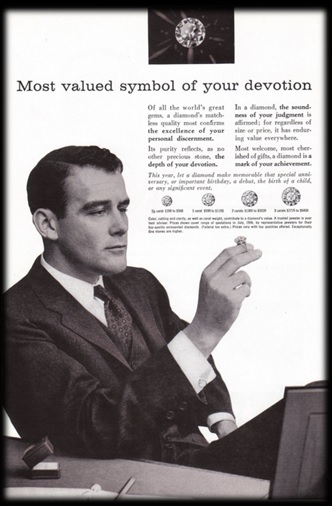A 1961 “Twilight Zone” episode centered around four thieves who’d stolen a million dollars of gold then placed themselves in suspended animation for 100 years. Their plan was to awake as rich men in the clear with their ill gotten gain.
The joke was on them. When they awoke in 2061, the greedy gang began killing one another over the gold. Badly injured, the sole survivor requested help from a couple passing by. He even offered gold as payment before he died. They were unimpressed. The husband even commented, "Imagine, offering gold as if it was worth something." The wife responded gold used to be valuable before they found a way of manufacturing it.
Are diamonds next?
One of the world’s largest diamond thefts took place on February 15, 2003, in the Antwerp Belgium Diamond Center. Police ultimately arrested a man who’d rented space in the center. The stones, valued at more than 100 million U.S. dollars, were never recovered.
Three days later eight police imposters stole 50 million U.S. dollars of diamonds from a jet on the runway at the Brussels Airport. The heist was accomplished without a shot being fired.
Ironically, the dollar loss, while staggering, isn’t real. Unlike most investment grade commodities, diamonds aren’t rare. Their value is based on market manipulation.
So why do people orchestrate sophisticated thefts and fight wars over almost worthless pieces of carbon? For the answer The Crime Files goes back more than 100 years.
Until the 1800’s world diamond production amounted to a few pounds a year. Then, in 1870, huge mines were discovered in South Africa. Suddenly, the shiny stones were being recovered by the ton. Realizing their investment was endangered, British financiers created DeBeers Consolidated Mines, a single entity powerful enough to control production.
By 1938 the DeBeers diamond monopoly was in serious decline. Many Europeans viewed diamonds for aristocrats only so the idea of a diamond engagement ring never took hold. With WWII around the corner, only the United States held any significant market potential for DeBeers.
Enter a most ingenious marketing scheme.
DeBeers hired New York based N. W. Ayer as their exclusive advertising agents for the U.S. and agreed to finance any necessary market research. Ayer soon discovered 90% of engagement rings were bought by men. For DeBeers to succeed the message needed to be diamonds were a gift of love so the larger the diamond, the greater the expression. Similarly, young women needed to connect diamonds to romance.
Popular movie stars were given diamonds to use as symbols of love and status. Celebrity magazines and newspapers then printed pictures of the celebrities giving diamonds to their loved ones. Others conspicuously showed the glittering stone on the hand of a well-known woman.
By 1941, U.S. diamond sales had increased by 55 percent.
In its 1947 strategy plan, Ayer reported, "With mass psychology we need to make the diamond engagement ring a necessity capable of competing at the retail level with utility goods and services."
In 1948 Ayer introduced the slogan, “A Diamond Is Forever."
Toward the end of the 50s, Ayer reported that twenty years of publicity had a pronounced effect on American psyche. "To the 1930s generation diamonds are a necessity.”
Things really heated up in the mid 60’s when DeBeers brought in the J. Walter Thompson agency to handle international advertising.
Thompson started in Japan by suggesting diamonds represented modern Western values. Soon Japanese magazines portrayed beautiful women displaying their diamond rings. The message was clear: diamonds were a sign of modern life.
Within ten years, DeBeers controlled a billion-dollar diamond market in Japan where non diamond based matrimonial customs had survived feudal revolutions, world wars, industrialization and even American occupation.
The Soviets almost derailed the cartel in the mid 60’s when diamonds were discovered in Siberia. In a classic case of, “if you can’t beat them join them”, DeBeers told the Soviets neither side could afford destroying the market so the Soviets were offered a partnership.
Since almost all uncut Soviet diamonds were under half a carat, and there was no outlet for millions of tiny diamonds, DeBeers changed gears and began marketing the "importance of quality, color and cut" over size. Now diamonds, regardless of size, were seen as objects of perfection.
DeBeers then introduced the "eternity ring," made up of as many as twenty-five tiny Soviet diamonds, to be sold to older married women with the theme of recaptured love. In reality, women received a ring of miniature diamonds because of the needs of a South African corporation to accommodate the Soviet Union.
Over time DeBeers proved to be the most successful cartel in modern commerce.
While other commodities, such as gold, silver, copper, rubber, and grains, fluctuated wildly in response to economic conditions, diamond “values” advanced upward every year since the Depression.
Even so, suspicions existed. In 1976, the Dutch Consumer Association tested the market by purchasing a one carat “perfect diamond” in Amsterdam. Eight months later they approached twenty leading dealers in Amsterdam to sell it. Nineteen refused and the twentieth dealer offered only a fraction of the purchase price.
Nevertheless, the DeBeers marketing plan worked so well that in the late 1970s even speculators began buying diamonds – a practice that continues in some parts of the world even today.
Over the last few decades the world has changed significantly. Satellites designed to find oil reserves, also show geology likely to hold diamonds. Australia was one of the first developed nations to discover major diamond resources. DeBeers was able to make a deal with them to distribute all the rough, except for the very rare pink diamonds.
After the collapse of the USSR, the Russians let their DeBeers contract expire and began to sell diamonds themselves.
Recently, diamond reserves have been found in Canada. DeBeers couldn’t make a deal with the Canadians, who are cutting and selling the stones themselves.
It’s difficult to predict where this all will lead. DeBeers still controls approximately 80% of the diamond market however if supply and demand ever meet prices will drop considerably. Perhaps a new, updated episode of the Twilight Zone will also be in order.





1956 DeBeers Diamond Ad

